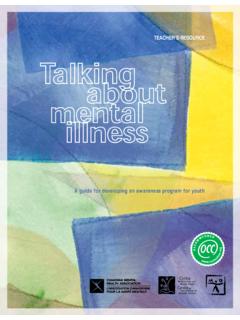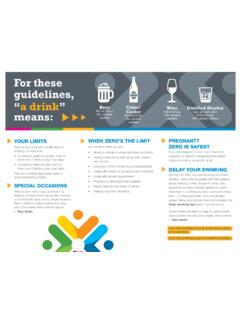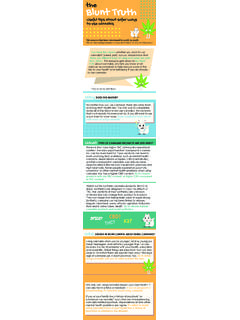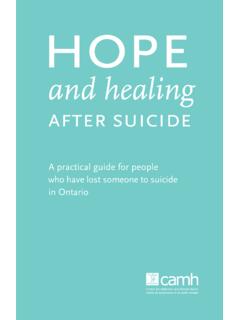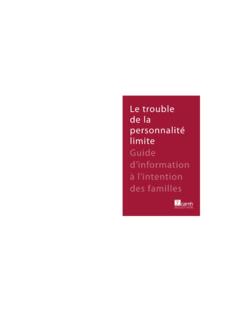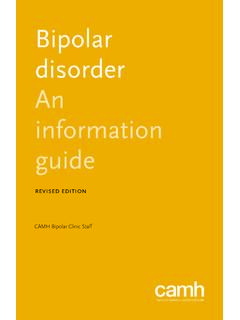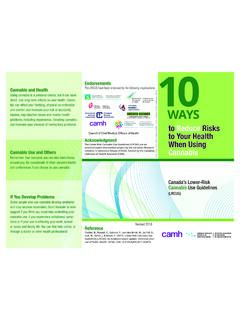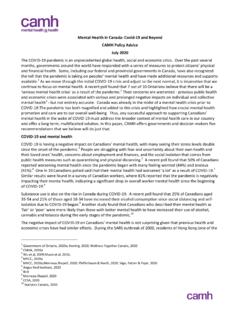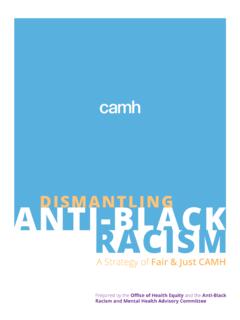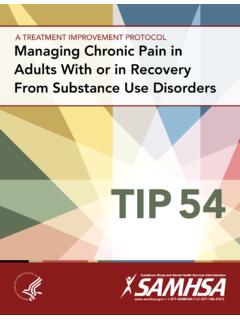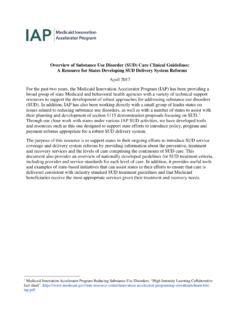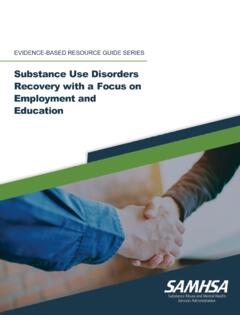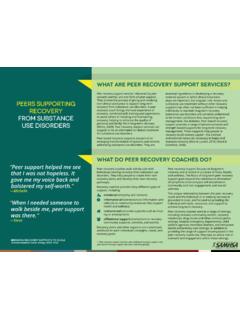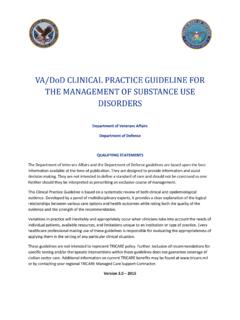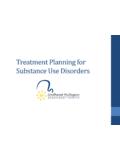Transcription of Concurrent substance use and mental health disorders An ...
1 Concurrent substance use and mental health disordersAn information Wayne Skinner, MSW, RSW; Caroline P. O Grady, RN, MN, PhD Christina Bartha, MSW, CSW; Carol Parker, MSW, CSWiConcurrent substance use and mental health disordersAn information Wayne Skinner, MSW, RSW; Caroline P. O Grady, RN, MN, PhD Christina Bartha, MSW, CSW; Carol Parker, MSW, CSWA Pan American health Organization /World health Organization Collaborating CentreLibrary and Archives Canada Cataloguing in Publication Concurrent substance use and mental health disorders : an information guide / Wayne Skinner .. [et al.].Issued also in electronic Dual diagnosis. 2. Mentally ill--Alcohol use. 3. Mentally ill--Drug substance abuse. 5. mental illness.
2 I. Skinner, W. J. Wayne, 1949- II. Centre for Addiction and mental health isbn: 978-1-77052-603-7 (print)isbn: 978-1-77052-604-4 (pdf)isbn: 978-1-77052-605-1 (html)isbn: 978-1-77052-606-8 (epub)Printed in Canada Copyright 2004, 2010 Centre for Addiction and mental HealthNo part of this work may be reproduced or transmitted in any form or by any means electronic or mechanical, including photocopying and recording, or by any information storage and retrieval system without written permission from the publisher except for a brief quotation (not to exceed 200 words) in a review or professional publication may be available in other formats. For information about alternate formats or other camh publications, or to place an order, please contact Sales and Distribution:Toll-free: 1 800 661-1111 Toronto: 416 595-6059 E-mail: store: : en fran ais sous le titre : Les troubles concomitants de toxicomanie et de sant mentale.
3 This guide was produced by the following:Development: Caroline Hebblethwaite, camh Editorial: Nick Gamble, camh; Kelly ColemanGraphic design: Nancy Leung, camh Print production: Christine Harris, camh 3973i / 06-2011 / PM039 ContentsAuthorship vAcknowledgment viIntroduction vi1 What are Concurrent disorders ? 1 How common are Concurrent disorders ?When do Concurrent disorders begin?2 What are the symptoms of Concurrent disorders ? 5 How severe are the problems?How does each problem affect the other one?3 What causes Concurrent disorders ? 94 How are Concurrent disorders treated? 10 Where do people get treatment?What is integrated treatment?Treatment goalsTypes of treatmentSpecial treatment situations5 recovery and relapse prevention 28 What does it mean to be in recovery ?
4 Preventing relapse and promoting wellness6 How Concurrent disorders affect families 32 What happens when someone you love has Concurrent disorders ?Getting treatment for your family memberCare for familiesBeing ready for a relapse or crisisTips for helping your family memberConcurrent substance use and mental health disorders : An information guide7 Explaining Concurrent disorders to children 40 How much should I tell the children?What to tell childrenOutside the homeDuring illnessDuring recoveryReference 45 Resources 46vAuthorshipThe Client and Family Information Guide series originated in the Social Work Department of the Clarke Institute of Psychiatry, one of the four organizations that merged in 1998 to form the Centre for Addiction and mental health (camh).
5 Since then, these guides have become an important part of the camh publishing program. Concurrent disorders is a relatively new field. To learn about it, we have drawn on the wisdom of people from a wide variety of mental health and substance use backgrounds. We thank the author teams who produced the other guides in this series: Christina Bartha Pamela Blake Dale Butterill David Clodman April Collins Robert Cooke Donna Czuchta Dave Denberg Martin Katzman Kate Kitchen Stephanie Kruger Alice Kusznir Roger McIntyre Sagar Parikh Carol Parker Jane Paterson Neil Rector Margaret Richter Kathryn Ryan Mary Seeman Cathy Thomson Claudia TindallCollaboration with camh Publication Services has been essential in creating this guide. Caroline Hebblethwaite and Anita Dubey deserve special recognition for their expertise and skill in produc-ing this substance use and mental health disorders : An information guideviAcknowledgmentThe authors would like to pay special tribute to clients at camh and their families who, through their openness, have taught us so guide is for people with Concurrent disorders and for their families.
6 It is also for anyone who wants basic information about Concurrent disorders , their treatment and their management. This guide should not replace treatment from a health professional. The term Concurrent disorders covers many combinations of problems. This guide talks about issues that are common to most Concurrent disorders . Other guides in the series offer more details about specific mental health problems (see page 51 for a list of titles). 11 What are Concurrent disorders ?A person with a mental health problem has a higher risk of having a substance use problem, just as a person with a substance use problem has an increased chance of having a mental health prob-lem. People who have combined, or Concurrent , substance use and mental health problems are said to have Concurrent disorders .
7 Concurrent disorders can include combinations such as: an anxiety disorder and a drinking problem schizophrenia and addiction to cannabis borderline personality disorder and heroin addiction depression and addiction to sleeping pills.(Addiction can be defined as the presence of the 4 Cs: Craving, loss of Control of the amount or frequency of use, Compulsion to use, and use despite negative Consequences.)Many other Concurrent disorders are possible, because there are many types of mental health and substance use problems. 2 Concurrent substance use and mental health disorders : An information guideA NOTE ABOUT LANGUAGEIn this information guide, we use the phrases substance use problem or mental health problem to describe the broad range of situations, from mild to severe, that a person with Concurrent disorders may experience.
8 We use the phrases substance use disorder or mental health disorder only where the text refers to a specific diagnosis. Concurrent disorders are also sometimes called: dual disorders dual diagnosis co-occurring substance use and mental health problems. In Ontario, the term dual diagnosis is used when a person has an intellectual disability and a mental health common are Concurrent disorders ? A large American study by Reiger and colleagues (1990) found the following rates: 30 per cent of people diagnosed with a mental health disorder will also have a substance use disorder at some time in their lives. This is close to twice the rate found in people who do not have a lifetime history of a mental health disorder. 37 per cent of people diagnosed with an alcohol disorder will have a mental health disorder at some point in their lives.
9 This is close to twice the rate found in people who do not have a lifetime history of a substance use disorder. 3 What are Concurrent disorders ? 53 per cent of people diagnosed with a substance use disorder (other than alcohol) will also have a mental health disorder at some point in their lives. This is close to four times the rate found in people who do not have a lifetime history of a substance use most common combinations are: substance use disorders + anxiety disorders substance use disorders + mood disorders . Anxiety disorders In general, 10 to 25 per cent of all people will have an anxiety disorder in their lifetime. Among people who have had an anxiety disorder in their lifetime, 24 per cent will have a substance use disorder in their depression In general, 15 to 20 per cent of all people will have major depres-sion in their lifetime.
10 Among people who have had major depression in their lifetime, 27 per cent will have a substance use disorder in their disorder In general, one to two per cent of all people will have bipolar disorder in their lifetime. Among people who have had bipolar disorder in their lifetime, 56 per cent will have a substance use disorder in their substance use and mental health disorders : An information guideSchizophrenia In general, one per cent of all people will have schizophrenia in their lifetime. Among people who have had schizophrenia in their lifetime, 47 per cent will have a substance use disorder in their lifetime. When do Concurrent disorders begin? mental health and substance use problems can begin at any time: from childhood to old age.
